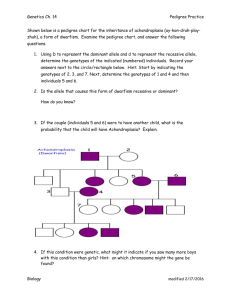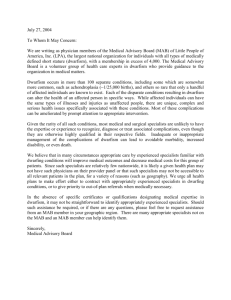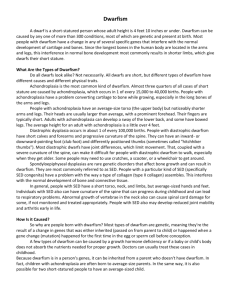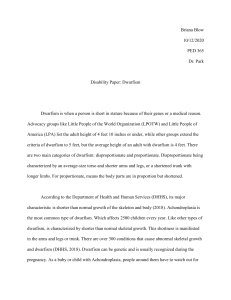Dwarfism
advertisement
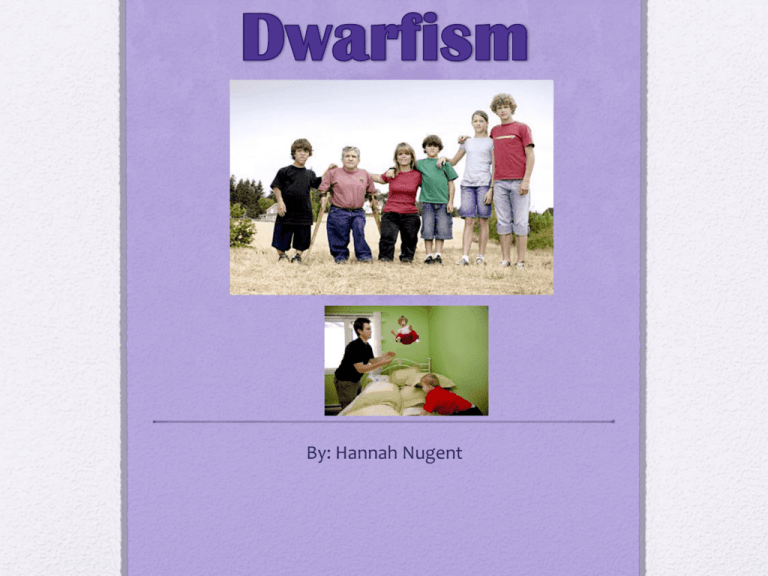
By: Hannah Nugent Types of dwarfism • There are an estimated 200 types of dwarfism. Dwarfism means that a person has an adult height of 4 feet 10 inches or shorter. • Most types of dwarfism are known as skeletal dysplasias, which are conditions of abnormal bone growth. They're divided into two types: short-trunk and short-limb dysplasias. • People with short-trunk dysplasia have a shortened trunk with longer limbs, whereas those with short-limb dysplasia have an average-sized trunk but small arms and legs. Inheritance Pattern A mutation in the fibroblast growth factor receptor 3 (FGFR3) gene Inheriting the gene from a parent with achondroplasia. Dwarfism is a autosomal dominant pattern, which means that one copy of the gene in each cell is sufficient to cause the disorder. Which means that if one of the parents with achondroplasia passes the FGFR3 gene on to the child, the child will likely develop the condition. Achondroplasia is the most common type of short-limbed dwarfism. The condition occurs in 1 in 15,000 to 40,000 newborns. The gender does not matter, is can occur in either female or male. Dwarfism is equally distributed between all types of people. Symptoms • As a child with dwarfism grows, other issues may also become apparent, including: • delayed development of some motor skills, such as sitting up and walking • a greater susceptibility to ear infections and hearing loss • breathing problems caused by small chests • curvature of the spine (scoliosis) • bowed legs • trouble with joint flexibility and early arthritis • crowding of teeth in the jaw Treatment/Cure/Deadly? • There is no treatment to cure dwarfism. Hormonal or metabolic problems may be treated with hormone injections or special diets to spark a child's growth, but skeletal dysplasias cannot be cured. People with these types of dwarfism can get medical care for some of the health problems that are associated with short stature. • Dwarfism can be deadly because of all of the complications and health problems they have, but mostly people that are diagnosed with dwarfism can live long fulfilling lives and this disease usually does not shorten the lifespan. Support groups • Human Growth Foundation 7777 Leesburg Pike (P.O. Box 309), Falls Church, VA 22043 Phone: (800) 451-6434 or (703) 883-1773Fax: (703) 883-1776 Web page: www.hgfound.orgLittle People of America (LPA), Inc.P.O. Box 745, Lubbock, TX 79408 Toll free help line: 888.LPA.2001 (24 hours daily, voice mail & fax E-mail: LPADataBase@juno.comRead more: Birth Defects - Support Groups - Achondroplasia http://www.medindia.net/patients/patientinfo/Support_Groups/Achondrop lasia.htm#ixzz1CBbyykjU Interesting Facts • Nine out of ten children with achondroplasia have normal sized parents. • Usually average sized kids with achondroplastic parnts are not at a higher risk of passing the disease to their children • Absolute prevention is NOT possible. • Dwarfism is not a reason to assume someone is incapable. Little people go to school, go to work, marry, and raise children, just like their average-size peers. • Dwarfism is not an intellectual disability. A person who has dwarfism is typically of normal intelligence. Diagnosis/Location of disorder. • Some types of dwarfism can be identified through prenatal testing if a doctor suspects a particular condition and tests for it. But most cases are not identified until after the child is born. In those instances, the doctor makes a diagnosis based on the child's appearance, failure to grow, and X-rays of the bones. Depending on the type of dwarfism the child has, diagnosis often can be made almost right after birth. • The FGFR3 gene is located on the short arm of chromosome 4 at position 16.3. This achondroplasia location on chromosome 4 can affect the gene's ability to direct the proper development and maintenance of bone. Johnson, Trevor. Dwarfism Disorders 3 January 2009 26 January 2011 http://kidshealth.org/parent/growth/growth/dwarfism.html Smith, Dylan. Dwarfism Support Groups Little People of America15 May 2010 26 January 2011 http://web.memberclicks.com/mc/page.do?sitePageId=37298&orgId=lpa



